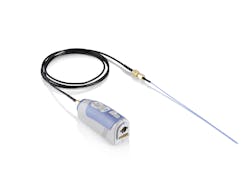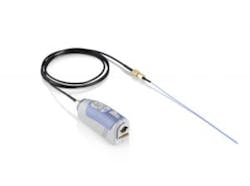Rohde & Schwarz debuts low-noise power-rail probes
At DesignCon this week in Santa Clara, Rohde & Schwarz is highlighting its new R&S RT-ZPR20 low-noise power-rail probe, which offers a bandwidth of 2 GHz and works in combination with the R&S RTE and R&S RTO2000 oscilloscopes. With its low inherent noise and an attenuation factor of 1:1, the R&S RT-ZPR20 probe enables users to measure and analyze in detail even small disturbance voltages using the many functions offered by the oscilloscopes, such as spectral analysis.
Thanks to the dynamic range of ± 850 mV and large DC voltage offset range of ±60 V, the probe permits analysis of the smallest disturbance signals during power-integrity measurements, even on DC power supplies with a high voltage level.The company notes that that the quality of the power supply is a key factor in the functionality and performance of sensitive electronic circuits—including IoT components with fast digital interfaces, fast memory chips, and sensitive analog circuits—where disturbance signals on the DC power-supply network can lead to EMC problems or impair circuit functionality.
The R&S RT-ZPR20 also features an integrated high-precision DC voltmeter that allows users to simultaneously measure a power supply’s DC component, irrespective of the offset voltage. This reading and the signal voltage are transmitted to the oscilloscope and displayed, allowing the DC level and ripple to be measured in parallel when qualifying power supplies for highly sensitive electronic components such as CPUs and FPGAs. Users see at a glance whether the ripple voltages lie within the often very tight power supply tolerances.
About the Author

Rick Nelson
Contributing Editor
Rick is currently Contributing Technical Editor. He was Executive Editor for EE in 2011-2018. Previously he served on several publications, including EDN and Vision Systems Design, and has received awards for signed editorials from the American Society of Business Publication Editors. He began as a design engineer at General Electric and Litton Industries and earned a BSEE degree from Penn State.

